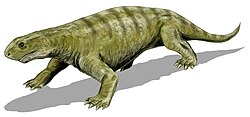Ennatosaurus
|
Ennatosaurus Temporal range: 265–254 Ma |
|
|---|---|
 |
|
| Scientific classification | |
| Kingdom: | Animalia |
| Phylum: | Chordata |
| Clade: | †Caseasauria |
| Family: | †Caseidae |
| Genus: | †Ennatosaurus |
| Type species | |
|
Ennatosaurus tecton Efemov, 1956 |
|
Ennatosaurus (meaning "the 9th reptile") was a synapsid that lived in European Russia during the Wordian stage of the Permian period. It is included in the synapsid clade Caseidae in the order Pelycosauria.
Ennatosaurus was a herbivore, and may have potentially been aquatic, using its broad forefeet for paddling. Like all caseids, Ennatosaurus had a small head compared to its wide, lizard-like body. Its mouth was lined with blunt, peg-like teeth. It lived alongside other Permian creatures, such as the herbivorous Nyctiphruretus and the carnivorous Biarmosuchus.
The adult size for Ennatosaurus is unknown. Fossil remains show an animal about the size of a cat, but these are likely juvenile specimens, the adults growing to sizes that may have rivaled those of 20-foot (6.1 m)-long cousin, Cotylorhynchus.[1] Ennatosaurus is known from only one fossil site, where several juveniles were buried simultaneously in sand. One adult skull was found among the juvenile skeletons.
http://scienceblogs.com/tetrapodzoology/2007/07/the_answers_we_seek_on_goodbye.php
http://www.palaeos.com/Paleozoic/Permian/Wordian.htm
Lucas, Spencer G. (1998) Permian Tetrapod Biochronology, Permophiles: Newsletter of the Subcommission on Permian Stratigraphy 32: 17–33
...
Wikipedia
